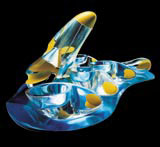Alessi serves up coffee sets by modern architects

More than 20 contemporary architects have created tea and coffee sets for the Italian design house Alessi, which will be unveiled this month.
The architects were briefed to think through the design of what is generally a functional domestic product in a refreshing way, resulting in a collection of pieces that combine architectural and design influences. They will be exhibited at the Sir John Soane’s Museum in London from 16 September.
Among the architects involved are: Future Systems, David Chipperfield, Alessandro Medini, Zaha Hadid, Greg Lynn, Will Alsop and Jean Nouvel.
Architecture has bled into Alessi’s product design before, with a previous collection of tea and coffee sets in 1983. They differ, Alessi owner Alberto Alessi says, in two ways: ‘First, there’s the opportunity to experiment with computer-aided design and, second, these designs have returned to a poetic, naive approach, going back to the origins of designing objects.’
According to William Palin, assistant curator of Sir John Soane’s Museum, the attraction of using architects as product designers is that, ‘architects are interested in product design, as they like to design everything down to the door handles – to have a totally designed environment’.
He adds, ‘I’m a little sceptical about how designers feel about architects encroaching on this product design territory, because architects take a new, un-practical look, but by pushing that envelope, they may be laying new ground.’
Architectural influences are instantly recognisable in several of the creations, such as the design by British architect Future Systems. Its main principle was to use heat-resistant transparent glass, creating an overall effect of a set that appears to be suspended in space. Palin says, ‘I find it interesting that all of the designs are completely different solutions to the brief, expressing the architects’ design philosophy distilled into a coffee set.’
British architect Alsop included in his a place for coffee or bon-bons, as Alsop thinks smoking a cigar and drinking coffee is an ‘event’ that, when shared, can ‘free you of all the tensions of modern-day life’.
Some designs, such as those by American architect Greg Lynn and Zaha Hadid, were more experimental. Lynn’s creation has been compared to a clove of garlic, while Hadid designed a sculptural formation around the idea of teatime taking on ‘a radically new meaning and becoming a sculptural enigma’. Alessi says that an architect designing this way is, ‘the only way they can work: experimenting in areas that are not yet discovered.’
He adds, ‘Some of the less experimental ones are important for their possibilities for production [techniques].’ Alessi cites Chipperfield, who created a silver service set, and Mendini, who offered a more organic interpretation of the brief, as examples. Mendini selected sculpted and hollowed-out, unfinished wood for his design, since the texture of the material conveyed the warmth of tea and coffee.
Alessi says the avant-garde designs of the tea and coffee towers are unlike domestic designs. He explains, ‘Architects usually work for single customers, so taking a risk is easier, but a company producing consumer goods has to face the so-called marketing, which is a strong brake to innovation and my personal biggest enemy.’
The exhibition will be staged at the Sir John Soane’s Museum from 16 September to 4 December.
-
Post a comment




